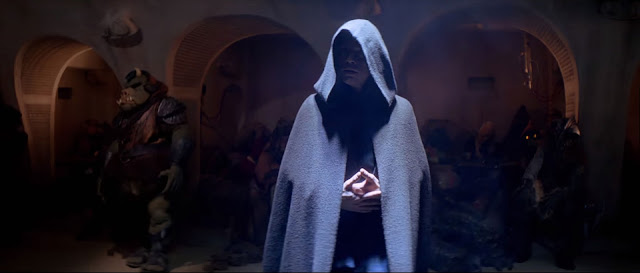[Update: I've revised and refined this idea
here.]
I recently read a module that featured a climb up a mountain. What struck me while reading it was just how unequipped this game is to deal with long, complicated, and difficult-to-describe actions.
This shows up most dramatically with small traps like those found in treasure chests. Large traps are easy: a hallway lined with slots on the walls and a beheaded skeleton on the floor is a great way to signal the presence of something menacing and it's up to the players to figure out the trigger in order to avoid or neutralize it. Just use the
3 clue rule and it becomes a solvable problem. Small traps, on the other hand, occur in places where you can both expect traps and have difficulty in perceiving them, and which may have complicated mechanisms that are difficult to describe to the players. The game should never devolve to resolving issues like this with saving throws alone.
Longer complications, like travel in hostile environments, are handled little better. Games have attempted to express the hostility of hot or cold environments at times but have usually added so many additional mechanics they get inevitably hand-waved.
 |
| Just make this into an RPG. |
Climbing, a seemingly obvious task that even children accomplish, provides a different set of problems. The most involved-and-still-interesting climbing mechanics are found in Patrick Stewart's Veins of the Earth. Every character can attempt climbs of varying difficulty: skill determines which types of climb are possible, while prep time determines how difficult it is, and those with points in the Climb skill can roll that too with a success with either passing. New checks are made whenever there are new climbing obstacles that weren't able to be studied from the previous inspection. Failure provokes a roll on a cascading table of bad effects. The alternative is the assumed default where characters can climb any surface, except for those they can't, which thieves can, and who may or may not need climbing gear, depending on the game, and probably a climb skill. Traditionally this has been managed with series of dice rolls, but rolling and rolling and
rolling until failure isn't fun or interesting.
A key feature of all of these scenarios is that none of them actually require that the character have or do anything specific. People climb seemingly impossible heights without gear, search and find hidden mechanisms, and survive treks in extreme weather in real life. Many might suffer or even die, but those are consequences player characters face every day. The important element in all of them is preparation, in many cases meaning "adequately equipped", and taking time to accomplish it carefully. Since Dungeons and Dragons already demands that players make choices about
what their character carries and a
recognition of the passage of time it is more than equipped to handle this. So here's a proposal.
Complex, un-timed, and preparable complications are rated on a scale of 0-3. Call it challenge degree, if you like. Each degree requires the characters have kit to meet it without it producing consequences.
Having access to the (deliberately undefined) kit usually means the character carries it with them. Usually, the kit required is obvious but by leaving it unspecified it allows for player ingenuity. It should turn these complications into problems that can be solved in a way that is both sensible and
natural, to produce more opportunities for adventure, until the complication is satisfied and then fades into the background. This works particularly well for a game like Knave which shines a spotlight on inventory, but any game that limits what a character can carry should be able to use this.
The big bonus is that it reduces the need for cumbersome skill systems. Some below mention "special training" but there is no reason that this has to be a class feature, it can simply be something the PCs acquire in downtime.
This is inspired by audit inventory, an idea I've heard expressed but never read about. The idea there is that inventory isn't carefully tracked most of the time. It's only brought up when characters attempt to carry an unusually large object (treasure chest, body) or when they try to exert themselves like running away, and then sheets are checked to ascertain whether they are carrying too much. Way "too much" means can vary but typically something like Significant Items vs Strength. Speaking of, "Fatigue" written below refers to a placeholder that takes up a space in the inventory of your encumbrance system of choice. It doesn't do anything else but take up space, and PCs can only reduce it by 1 each time they sleep.
Extreme Cold
 |
| Some shelters are unconventional. |
- Wearing dry winterized clothing
- Occupying sturdy shelter
- Hot food
Consequences: Gain 1 fatigue per missing kit per day. Each time you accrue fatigue this way, make a saving throw to avoid halving current and maximum hit points until the fatigue is cleared.
Your typical European setting might have Cold-0 the majority of the year, so the PCs will never have to worry about it. Come winter it advances to Cold-1. At this point, the PC requires at least 1 bit of kit or preparation to avoid consequences. Having a fire at camp (assuming they have rations available) would cover hot food in my book but may be from less savory provenance. Travel into the mountain would require additional material, the construction of sturdier shelters, special clothing, and the like. I notably left out "fire" because it's the obvious way to dry out wet clothing in order to meet the first challenge requirement. Dungeons would count towards sturdy shelter so that particularly cold dungeons should stand out.
Extreme Heat
 |
| You know you've always wanted to run this. |
- Water
- Protections from the sun
- Avoid exertion
Consequences: Gain 1 fatigue per missing kit per day. Each time you accrue fatigue this way, make a saving throw to avoid halving current and maximum hit points until the fatigue is cleared.
The other pole of extreme cold, extreme heat can be used for desert-like settings or for hell (barring the cosmology of Dante). Since protection from the sun will be difficult to achieve while doing anything, PCs will be encouraged to travel at night. Since they want to avoid exertion, they will want to have animal transport even if it's not very fast. And obviously, they will require a lot of water. The point of each challenge should be to spur player action in ways that establish the setting. If the setting is a hedonistic paradise of abundance, nothing need be tracked. If the prevailing conditions are hot, then pushing players to deal with heat helps make an area feel different.
Small Traps and Locks
 |
| "Small" is relative. |
- A turn of careful work
- Training in the detection and disabling of small traps
- Special tools
Consequences:
Failure by 1: roll under dexterity to succeed anyways, otherwise hear a "click".
Failure by 2: roll under dexterity to be warned with a "click", otherwise make a saving throw or suffer the trap.
Failure by 3: make a saving throw or suffer the trap.
Yes, this means that the thief can spend a turn and unfailingly resolve all traps.
JB argues that thieves shouldn't have to roll to do what their class does, anyways. The "click" refers to
a method of trap activation where the PC triggers the trap but is notified before it activates, and if they describe a method of avoiding it that would work according to the DM, they experience reduced effect. In this case, if they describe an immediate action that would avoid the trap, they suffer no ill; otherwise, roll a saving throw as normal. Traps, by their nature, give fewer ways to meet the challenges and so require more nuance to the consequences.
Climbing
 |
| Lidda? |
- Inspection of the whole route
- Climbing gear
- As much time as required
Consequences: Roll under constitution once for each piece of missing kit. Fail once and take damage as having fallen 10', (or twice your level in damage if you have no falling mechanics) as you wrench your shoulder catching a ledge just below. Fail twice and taking half your hp in damage and crack a rib landing on a ledge below. Fail 3 times to fall all the way, however far that may be.
Time, in this case, is specifically left undefined. Climbing challenges come in two varieties: those that must be done quickly, and those that can be done carefully. By requiring inspection of the whole route, characters might be required to seek out alternative vantages, or use clairvoyant magic to see the route far above, or simply take their time and move from ledge to ledge. Since these are failures of proactive player action, they seemed more appropriate as ability checks than saving throws, but I could have gone either way. Constitution was chosen because climbing is about sustained exertion more than brief muscular force.
 |
| Oddly menacing. |
Lifting a Portcullis
- Assistance from another person or tool
- Assistance from another person
- Assistance from another person
Consequences: Everyone rolls under strength to lift. Succeed or fail, take 1 fatigue for each bit of missing kit. If a PC's fatigue causes them to exceed their limit, they drop it at an inopportune moment and everyone involved must make a saving throw or suffer damage as per falling.
It's a big heavy thing. Have 3 other people help, or two others and a lever or other improvised assistance, and it's no problem. Lack of any of those and it becomes more challenging. This can be generalized for other feats of strength like the classic Bend Bars. The important part is that it provides a challenge for much of the party. Combine it with a threat that also requires the party's attention for maximum effect.
Disguises
 |
| Sometimes it's the only way. |
- Study the target's mannerisms
- Wear appropriate attire
- Conceal face
Consequences: Require successively more difficult reaction checks to maintain the disguise.
There's really no binary for whether or not a disguise works so lacking kit requires greater and greater degrees of persuasion. For some settings (
mawashi) achieving the required level of kit isn't going to be possible regardless, while in others (
niqab) the face concealment is integrated into the attire and so counts for both. It's important that kits create different objectives. Attire can be bought or stolen, but getting the mannerisms right requires extended close contact, instruction from someone familiar, or magical trickery. Concealing the face is most tricky, likely requiring hair-styling or wig, makeup, a veil or other obscuring headwear, a (fake?) beard, or various other additions to really sell the deception.














